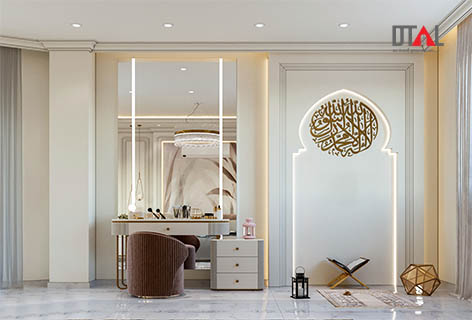What Is The Difference Between Architecture And Interior Design?
Interior design and architecture are two separate but related fields. The design and construction of structures emphasizing structural soundness and visual appeal is referred to as architecture. Conversely, interior design involves the planning and enhancement of interior spaces, emphasizing functionality and ambiance. Understanding the disparities between these disciplines is crucial for professionals and enthusiasts alike, as it enables effective collaboration and ensures the successful execution of design projects. Transitioning from this overview, we delve deeper into architecture and interior design’s specific definitions and roles.
1. Definitions Of Architecture And Interior Design
A. Architecture

The art and science of creating buildings and other tangible structures is known as architecture. In architecture, the scope of work entails developing a building’s general plan and arrangement while considering sustainability, safety, aesthetics, and utility. The primary goals and objectives of architecture include:
- Designing areas to fulfill the users’ requirements.
- Harmonizing with the surrounding environment.
- Embodying the vision and values of the client or community.
B. Interior Design

Interior design is the art and science of improving a building’s interior areas to create a more aesthetically pleasant and healthy environment for those who use them. The scope of work in interior design encompasses planning and arranging the interior elements of a space, including furniture, finishes, lighting, and décor, to optimize functionality, circulation, and visual appeal.
Also, Interior design is to create environments that reflect the client’s personality or brand identity, enhance productivity and well-being, and make the most effective use of available space.
2. Roles and Responsibilities
In the realm of design, architects and interior designers play distinct yet complementary roles. Architects conceptualize and design the overall structure of buildings, while interior designers focus on creating functional and aesthetically pleasing interior spaces.
Architects oversee the entire architectural process, from initial conception to construction completion. They translate clients’ needs and desires into tangible designs, considering structural integrity, building codes, and sustainability. Architects work closely with engineers and contractors throughout the design phase to guarantee the project’s success.
Interior designers, on the other hand, concentrate on optimizing interior spaces for practical use and visual appeal. They work closely with clients to understand their lifestyle preferences and design goals, incorporating furniture, lighting, and color schemes to enhance the overall ambiance. Interior designers also consider traffic flow, spatial layout, and accessibility to create harmonious and functional interiors.
While architects focus on buildings’ external form and structure, interior designers prioritize the internal layout and aesthetics. Despite their distinct roles, both professionals collaborate to achieve cohesive and integrated designs that meet clients’ needs and expectations. This collaboration ensures that every aspect of the built environment—exterior architecture to interior spaces—is thoughtfully designed and executed.
3. Design Process Architects & Interiors

In architectural design, the process unfolds through several stages. It begins with conceptualization, where ideas take shape. Next, schematic design lays out the basic framework. Then, design development refines the details. Subsequently, construction documentation specifies execution plans, followed by construction administration overseeing the project’s realization. Key considerations such as functionality and aesthetic appeal guide the architectural design process.
Similarly, interior design follows a structured path. It starts with programming and gathering requirements and objectives. Then, the schematic design visualizes concepts within the space. Design development further refines these ideas. Construction documentation translates designs into actionable plans, leading to implementation. Here, attention to elements like spatial arrangement and material selection drives the interior design process.
4. Education and Training
In the realm of education and training, both architecture and interior design require distinct paths.
Architectural education involves degree programs where aspiring architects pursue bachelor’s or master’s degrees. Following this, licensing requirements necessitate passing rigorous exams, ensuring a high standard of competence. Specializations and certifications allow architects to focus on niche areas, enhancing their expertise and marketability.
Similarly, interior design education comprises degree programs tailored to equip students with essential skills. Licensing requirements mandate the successful completion of exams, validating the proficiency of interior designers in various aspects of their field.
In essence, both architectural and interior design education pathways emphasize a combination of academic training, professional assessments, and optional specializations to cultivate well-rounded and competent professionals.
5. Collaboration and Integration
Collaboration between architects and interior designers is crucial for successful projects. By working together, they can combine their expertise and create cohesive designs. For example, in a residential project, the architect may focus on structural elements while the interior designer considers furniture placement and finishes. This collaboration ensures that both the external and internal aspects of a space harmonize effectively.
However, misconceptions often arise regarding the roles of architects and interior designers. It’s essential to clarify these misunderstandings to appreciate the distinct contributions each profession brings to a project. Architects primarily deal with the overall structure and functionality of a building, while interior designers focus on enhancing the interior environment, including furniture selection and spatial arrangements.
Overall, effective collaboration and clear distinctions between architecture and interior design lead to well-executed projects that fulfill both aesthetic and functional requirements.
6. Conclusion Of Architects & Interior Design
In conclusion, we’ve highlighted the fundamental disparities between architecture and interior design. Recognizing these differences is crucial, enabling clarity and precision in each profession’s execution. Moreover, understanding the distinct roles opens up various career paths and opportunities within both fields. Ultimately, it’s imperative to appreciate the dynamic relationship between architecture and interior design, as their collaboration often leads to harmonious and functional spaces that enrich the built environment. When striving for excellence in crafting such spaces, choosing the best vacuum cleaner can significantly contribute to maintaining cleanliness and enhancing the overall quality of the design.

Add Comment